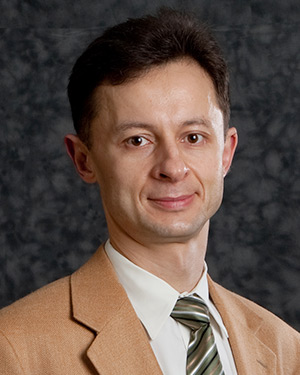Recognizes Contributions to Education, Research and Community Service
Vassiliy Lubchenko, associate professor of chemistry in the College of Natural Sciences and Mathematics, has been awarded the 2017 American Chemical Society-Greater Houston Section Joe W. Hightower Award.
 This award, which recognizes contributions to education, research, sectional service
or community service, comes with a plaque, which will be awarded during the ACS-GHS
Fall Awards Banquet.
This award, which recognizes contributions to education, research, sectional service
or community service, comes with a plaque, which will be awarded during the ACS-GHS
Fall Awards Banquet.
Lubchenko, a faculty member at the University of Houston since 2005, researches the mechanism of the formation of inorganic solids with a particular focus on amorphous solids that are called glasses.
“Glass is a type of solid in which the atoms are arranged in an irregular fashion,” Lubchenko said.
Different types of glass are used in many important industrial applications, including optical fibers for high-speed internet, smartphone screens, as well as rewritable CD-ROMs and Blu-ray discs.
Lubchenko’s research group studies a technologically important family of glass-forming compounds known as chalcogenides. The work addresses how these materials switch from an amorphous solid, with a disordered arrangement of atoms, to a crystalline structure, where the atoms are neatly lined up.
“One of the leading candidates for next-generation computer memory is based on the idea that chalcogenide glasses can be in two different structural states, either amorphous or crystalline,” Lubchenko said. “These two different states can be a way to record 0s and 1s, which is what a computer uses to store and manipulate information.”
In addition to his work on chalcogenides, Lubchenko is involved in a long-running collaboration with Peter Vekilov, Moores Professor of Chemical and Biomolecular Engineering. This project examines the properties and molecular origin of a puzzling type of protein aggregation, where protein solutions house clusters of concentrated protein solution that are just under a micron in size. Because of their size, which is intermediate between the microscopic, atomic length and the macroscopic, humanly-relevant length scale, these clusters have been called "mesoscopic."
“At first glance, if protein aggregates were to emerge in a solution, the prediction is that they should either evaporate or grow indefinitely. Instead, they somehow remain at this very mysterious size,” Lubchenko said.
These protein aggregates play a role in diseases such as sickle cell anemia, where the polymerization of mutated hemoglobin molecules causes red blood cells to curl up, or other disease caused by protein aggregation such as Alzheimer’s.
“We have made a strong case that there are long-lived complexes, in which individual protein molecules bind together to transiently stabilize mesoscopic droplets, before falling apart,” Lubchenko said. “If we can control the formation of these clusters, then we can possibly prevent or mitigate these protein diseases.”
The ACS-GHS Fall Awards Banquet will be held on September 22, during which Lubchenko will also give a brief talk on his research.
- Rachel Fairbank, College of Natural Sciences and Mathematics